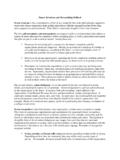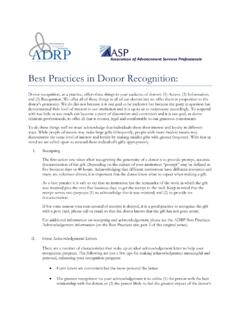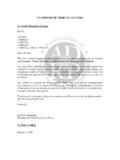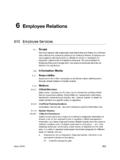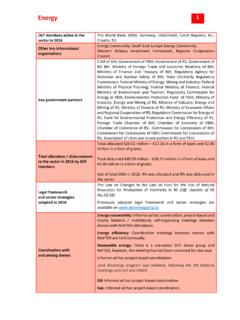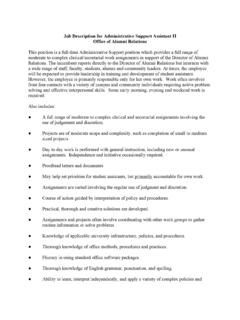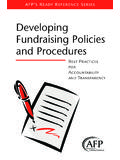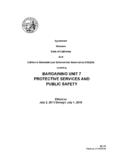Transcription of Donor Relations and Stewardship Defined - ADRP
1 Donor Relations and Stewardship Defined Donor Relations is the comprehensive effort of any nonprofit that seeks philanthropic support to ensure that donors experience high-quality interactions with the organization that foster long-term engagement and investment. This effort is commonly thought to have four elements. The first, gift acceptance and management, encompasses policies and procedures that address a variety of issues that must be considered before accepting gifts, as well as procedures that ensure that gifts are put to work as donors intend. Among these are: Processes for reviewing gifts to ensure that the Donor s intentions and the organizations needs are congruous. Having an up-front understanding of whether or not a gift can be deployed according to the Donor s wishes can mitigate a loss of goodwill and, possibly, the need to return a gift in the future.
2 Structures for giving opportunities, including the levels required to establish endowed funds, or to be recognized with named spaces, on Donor walls or in giving societies. Procedures for tracking the expenditure of gifts to ensure that they are being used according to donors intentions, and mechanisms for rectifying situations where they are not. Importantly, organizations need to have processes for handling gifts that can no longer be utilized because of changes in programming or external factors such as changes in laws. These processes need to address instances where the Donor is living as well as those where the Donor is deceased. The second element, acknowledgment, covers the protocols for and execution of accurate, timely, and meaningful expressions of gratitude.
3 Acknowledgement is a private action directed by the organization to the Donor . It includes both gift receipting, which addresses the requirements of the Internal Revenue Service, and personalized, written correspondence. It might also include emails, phone calls, and visits. In most cases, the most heartfelt and impactful acknowledgements come from those who directly benefit from a Donor s generosity for example, clients of a social services agency, artists of a performing arts company, or students of a college or university. Donor recognition is the third element, and, importantly, includes Donor recognition events. This element incorporates opportunities and mechanisms for meaningful Donor recognition, taking into consideration such factors as donors preferences (for example, anonymity and the format in which their names are presented) and institutional culture and values.
4 Recognition is the public form of Donor acknowledgement, and ranges from activities that are automatic organizational responses to giving, such as giving societies, to those that are undertaken with the involvement of the donors , as is the case with named space signage. Examples of recognition programs include: Giving societies and honor rolls categorize donors according to their levels of giving. Depending on how they are structured, they may reflect only a certain type of giving for example, giving to annual funds only, to certain areas of the organization, or during a specified period of time, such as during a campaign or may be Defined to be cash-based or to include pledges to give in the future. The treatment of particular forms of giving, such as deferred or planned gifts, and gifts-in-kind, must also be determined when giving society and honor roll programs are developed.
5 Giving societies often incorporate tiers that incent donors to reach to higher levels of giving. The tiers are generally named and may offer differential benefits or courtesies. For some organizations it is appropriate for the benefits to have tangible value, which then impacts the tax deductibility of gifts as stipulated by the Internal Revenue Service. It is increasingly common, however, for such benefits to offer access to the content and leadership of the organization, thereby mitigating the quid-pro-quo issues that organizations must manage. Honor rolls also categorize donors according to levels of giving and are usually incorporated into print publications, such as campaign progress reports and annual reports, to signal the specific contributions of individual and organizational donors in the context of the total raised.
6 While most donors will say that they do not require this form of recognition, many will be candid about the fact that it s of interest to see where they stack-up in relation to other supporters. This type of friendly competition can be a very useful tool in fundraising. The preparation of honor rolls can be tedious, and they must be checked multiple times to assure that they are error free. The ability to make changes as necessary, as well as cost savings offered, are strong reasons to move the delivery of honor rolls from print to online. This, in fact, is a very frequent topic of best practice research. This decision, however, must take into account the potential impact on donors , particularly those giving at major and principal gift levels, and must be in-line with the overall communication strategy of the organization.
7 Donor walls and named space signage provide very visible recognition, usually for those giving to campaigns and capital projects. Donor walls can also be used to recognize annual and lifelong giving. It is critical to define standards for listings, and to confirm those standards with internal decision-makers, before approaching donors about listing options. A very important consideration for both types of physical recognition is the handling of the removal of walls and signage when spaces are re-purposed or demolished. Organizations should have policies for dealing with these situations, and should communicate early with donors , or heirs of donors , who will be affected. Donor profiles in publications such as newsletters, magazines and annual reports, as well as their online counterparts, and external publicity such as press releases, are also very public forms of recognition.
8 donors or their representatives should be actively involved in the preparation and review of these materials to mitigate potentially embarrassing errors or omissions. Donor recognition events, awards, mementos and volunteer engagement opportunities are also important forms of Donor recognition. They can be features of giving societies, annual funds, and campaigns, or can stand-alone as opportunities to engage and cultivate donors as they move toward their next gifts. Events have a prominent place in the Donor Relations toolkit because they are an effective way to reach and foster long-term relationships with a broad spectrum of donors . As such, they are often the focal point of the work of Donor Relations professionals, and can range from large-scale events where the objective is to create and reinforce connection, to intimate gatherings that deepen personal relationships between the organization s leadership and its most important donors .
9 The final element is reporting to donors on the impact of their gifts on the mission of the organization. This involves standards, systems and methods of delivery for demonstrating fiscal accountability prudent investment and spending in accordance with donors expectations to donors , to convey ongoing appreciation, and to report on the impact of philanthropic support. Reporting falls into two broad categories: 1) qualitative, which is the storytelling that confirms to the Donor that the investment was a sound one because the support is making a difference in the mission of the organization, and 2) quantitative, which verifies the carrying-out of fiduciary responsibility. Further, reporting can be included in print and online vehicles that are broadly distributed, or can be highly personalized.
10 The latter can range from simple financial reports regarding the status of an endowed fund to comprehensive philanthropy impact reports that chronicle several decades of investment in the organization. Information technology tools are providing opportunities to mass-customize reports, so that each follows the same templated format but includes Donor -specific data. It is common today for this element to be referred to as Stewardship . This word, however, has been Defined historically as the safeguarding of the assets of others and, therefore, is considered by some to be misused in the context of donors , as in Donor Stewardship . Rather, these individuals state that it is gifts, not donors , that are stewarded. In this view, the activities associated with Stewardship are focused on ensuring that the funds provided by donors are utilized in the way intended as conveyed in gift agreements and fund terms.
